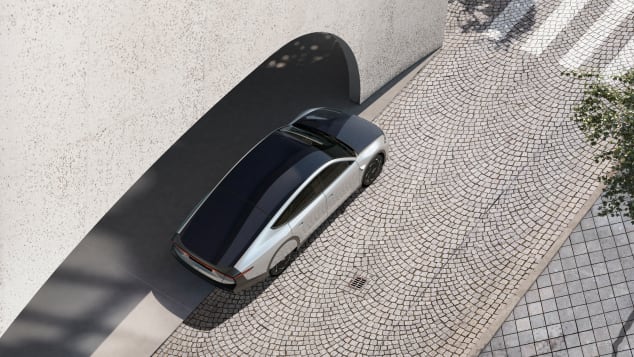Dutch company Lightyear has announced that this fall it will start making the world’s first production car fitted with solar panels.
The Lightyear 0 will have curved solar panels in its roof, hood and trunk that top up the electric battery as it drives (or remains parked) and the first delivery in Europe could be as early as November.
The company says the car will be able to drive around 388 miles without stopping to recharge, and will have an additional range of up to 44 miles a day from the solar panels. For comparison, that’s slightly more than a Tesla Model 3 (374 miles), and significantly more than the Kia Niro Long Range (285 miles).
Each hour in the sun will add up to six miles of charge to the battery, according to Lightyear. The solar range will give an added drip feed of miles for long journeys but also means you’ll spend less time at charging points — or may not even need them at all. The company says that in a hot county such as Spain or Portugal, if your daily commute is less than 22 miles, you won’t need to plug in the car for up to seven months. In a cloudier climate, like the Netherlands, the car would need charging after two months.

A rendering of the Lightyear 0.
Smaller battery, lighter car
The “0” has much in common with the Lightyear One prototype that was unveiled two years ago, but is able to do more with a smaller battery, says company CEO and co-founder Lex Hoefsloot. “The powertrain is the most efficient in the world,” he claims, adding that the car’s aerodynamic shape and four in-wheel motors enable a smaller battery to provide the same range.
That means “the whole car is lighter,” he says, “and you get into this positive feedback cycle where everything can become lighter as well. That’s how we’ve been able to get to 1,575 kilograms. If you look at other cars that offer similar range, they’re all about 40% heavier.”
Other companies are developing cars with solar panels, but none are ready to hit the market yet. The Sono Sion, slated for production in 2023, promises to provide an average of 10 miles of solar range per day. The Aptera Never Charge is a futuristic-looking three-wheeler that the company claims will collect about 40 miles’ worth of solar energy a day. Aptera told CNN that it hopes the car will enter production in 2023, and it already has 24,000 reservations.
But while the whole concept of the Lightyear 0 may be based around improving efficiency and cutting charging time, it has a maximum speed of just 100 mph, while its 0 to 100 mph time is a sluggish 10 seconds, something that Hoefsloot admits is down to a focus on range.
It’s expensive too: One of the 946 launch models will set you back €250,000 ($262,000) — slightly more than a Ferrari Roma, and some distance clear of mid-range family EVs like the Nissan Leaf (around $27,000 in the US) or the Tesla Model 3 (around $50,000).
The company hopes to launch a “people’s model” — the tentatively named Lightyear Two — by 2025, that will retail for around €30,000 ($31,215).

